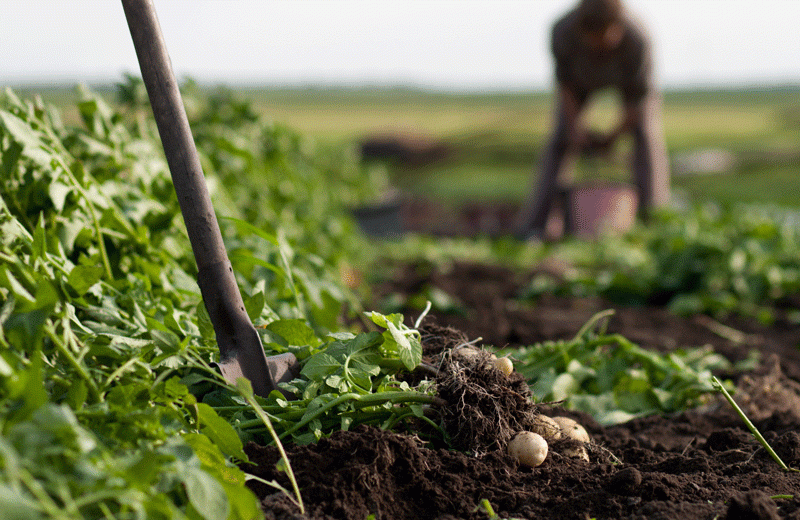With training, access to credit, farmers can reclaim breadbasket role
Share

Harare, (New Ziana) – Historically, agricultural
production has been a major accelerator of Zimbabwe’s economy, heavily
relying on large-scale commercial farming while smallholder subsistence
farming faced stiff production challenges.
During the 1980s and 90s, cotton richly paid for farmers, and was
considered the country’s white gold, but this status declined over the
years due to low international prices, which forced growers to find
other more rewarding crops.
From 2000, smallholder farmers became the primary agricultural producers
as the Government embarked on a massive land reform programme to address
colonial land ownership imbalances which favoured the minority whites.
The programme involved the compulsory acquisition of excess farmland
from white farmers to resettle landless blacks, to economically empower
them.
But the majority of the resettled farmers lacked the technical
expertise, had no access to credit and inputs, and did not have market
information needed to enter the more demanding commercial agricultural
space. This led to an overall decline in agricultural production in the
country, a breadbasket for Africa.
The story was also disturbing in the livestock sector. The livestock
sector provides income and employment to farmers, agricultural service
providers, and other actors involved in the value chain in Zimbabwe. The
country’s livestock production system is characterized by small-scale
subsistence farming. Despite the importance of livestock to rural
livelihoods, the sector’s productivity remains pitifully low, a
situation that is linked to farmer behaviour, feed unavailability and
cost, poor quality of animals, diseases and frequent droughts.
To address livestock production challenges, in 2019, the European Union(
EU) embarked on a five-year 40 million Euro partnership with the
Zimbabwe Government, private sector organizations and non-governmental
organizations and unveiled the Zimbabwe Agricultural Growth Programme
(ZAGP) that would ultimately increase agricultural incomes and
employment development opportunities for smallholder farmers in the
livestock sector.
“The program commercialized smallholder livestock farming by increasing
incomes and improving their food security and nutrition through hands-on
agricultural training, technical assistance and farming as a family
business,” says the Team Leader to the Technical Assistance to ZAGP,
Munhamo Chisvo.
“The farmers also improved their livestock production systems,
simultaneously increasing access to markets and affordable lines of
finance, ensuring equal access for women and young people in the
process,” he adds.
ZAGP covered the country’s 10 provinces. As a result of the program’s
successes, beneficiary households transformed from subsistence to
smallholder livestock commercial farmers and increased their average
annual incomes from agricultural production.
One of the ZAGP projects is the Transforming Zimbabwe’s Dairy Value
Chain (TranZDVC) project which mobilized and registered more than 4,000
new dairy farmers between 2019 and 2022.
TranZDVC addressed the root causes of under-performance in the dairy
value chain by strengthening financing, production, processing and
market linkages. The project worked with over 4,800 dairy farmers
countrywide. These included small-scale, medium and large-scale dairy
farmers.
Esther Marwa, of Nharira area in Chikomba district in Mashonaland East
Province, was one of TranZDVC’s beneficiary farmers. Marwa was the
overall winner of the 2021 Small-scale Dairy Farmer of the Year
competitions. Her current production of 19 litres of milk per cow per
day supports the government’s growth growth plan on rebuilding the dairy
sector, strengthening and expanding the dairy rehabilitation program.
Marwa took dairy farming as a business in January 2019 with five in-calf
Holstein heifers which she had bought from a large-scale dairy farmer.
Currently, her total herd size is 31 dairy cows and four dairy bulls.
“I am currently milking 12 dairy cows (nine are in-calf), three are dry,
eight heifers, six weaners, two calves and four dairy bulls,” said
Marwa.
“My highest milk producer gives me 25 litres of milk per day. The daily
milk yield is about 150 litres,” she adds.
To increase dairy production and productivity, TranZDVC imported 500
in-calf heifers from South Africa between 2020 and 2021 and were
distributed to 282 smallholder dairy farmers across Zimbabwe. The dairy
cows were distributed to different areas through a heifer matching grant
facility led by three private companies – Dendairy, Nestle Zimbabwe (a
conglomerate with dairy interests in Zimbabwe) and ProDairy.
TranZDVC also promoted investment in dairy productive assets and
infrastructure to ensure access to finance for dairy producers through a
Matching Grants Facility. The Matching Grant Facility was limited to
capital investments in productive assets such as machinery, equipment
and buildings and did not include finance for working capital and
services. At least US$2,000,000 worth of grants was disbursed, and
targeted large-scale farmers, processors and milk collection centres.
The national beef cattle herd declined by 5.7 percent from 5,774 525
cattle in 2018 to 5,443,770 cattle in 2019.
The Beef Enterprise Strengthening and Transformation (BEST) project,
another initiative under ZAGP, was implemented in five provinces of
Zimbabwe. BEST focused on creating a robust, competitive beef value
chain that promoted enhanced trade, employment creation, food security,
and inclusive economic growth by 2023 for 25,000 small to medium as
well as commercial farmers. Sustainable private sector partnerships with
beef farmers were also established.
“Perhaps the most notable achievement of BEST was the establishment of
cattle business centres managed by the private sector,” says Project
Team Leader, Mark Benzon. “The cattle business centres have created hubs
of production, extension and marketing activities for beef farmers who
access input and output markets, financial and reproductive services,
fodder production and animal husbandry training,” Benzon says.
Ten cattle business centres with 50 satellites were established. The
Balu Cattle Business Centre in Umguza district in Matabeleland North
Province, for example, and the Lapachi Centre in Mwenezi district in
Masvingo Province, have irrigated pastures under centre pivots.
Small-scale poultry farmers produce 75 percent of the country’s poultry.
Interventions have been implemented to help and increase the
productivity of these farmers, which is likely to have a good impact on
poultry output.
Producers’ profitability is, however, threatened by stiff competition
from low-cost imports of both table eggs and meat. Poor harvests due to
droughts, rising input costs, particularly maize and soya meal, as well
as significant volumes of illicit imports sold in the domestic market at
sub-economic rates, have had a negative bearing on the poultry business.
The Inclusive Poultry Value Chain (IPVC) project under ZAGP focused on
the development of an efficient poultry value chain in Zimbabwe. The
broiler value chain was one of the fastest growing sectors in Zimbabwe
during the last decade, with an estimated growth rate of 50 percent in
three years (from 88,000 tonnes in 2012 to 132,000 tonnes in 2014).
However, following a period of macroeconomic decline compounded by an
outbreak of Avian Influenza in 2017, there has been an overall decline
in growth of 10 percent in the sector. Most of the broiler production is
carried out by small and medium producers whose recovery is vital for
the inclusive growth of the sector. The IPVC project operated in
Bulawayo, Gweru, Harare, Mutare and Masvingo, focusing on 7,500 broiler
and 2,500 egg small to medium producers.
The IPVC project developed productive capacity of 11,600 small-scale
poultry producers, and helped organize 3,153 of these into Producer
Business Associations (PBAs), which were later registered as cooperative
companies.
IPVC established poultry business units across five clusters in
Bulawayo, Gweru, Harare, Masvingo and Mutare. “The poultry business unit
enables poultry farmers to access extension, inputs, financial and
market services in a more convenient and profitable manner,” said
Chisvo.
In addition, the poultry business unit negotiates for bulk purchases of
day old chicks and feed and results in reduced cost of production,
increasing revenue and training in poultry production. Poultry farming
has become a source of income for many unemployed people in the country,
particularly women.
“I believe it is useful to work collectively when it comes to poultry
farming, because working alone can be difficult. It is useful to share
ideas, products, and market advice,” said Brenda Tawanda of Manica
Bridge in Mutare district in Manicaland Province.
The Value Chain Alliance for Livestock Upgrading and Empowerment (VALUE)
worked on transforming and promoting the goat and pork value chains in
the country. VALUE was implemented in 20 districts (12 for the goat
value chain and eight for pork value chains from six provinces. The
project trained smallholder farmers-especially women and youth, to
improve their goat and pig breeds, production and productivity, and
facilitated access to viable markets.
At least 3,199 goats with a total of 40,352kg of meat were sold to 43
butcheries in Harare and Bulawayo markets by 868 farmers.
In addition, 244 pigs were imported and 3,071 offspring of imported
genetics were sold from breeder farms to farmers.
“The ZAGP showed the viability of commercializing smallholder livestock
production and changing the status of smallholder farmers from poor to
middle class citizens using carefully structured mechanisms,” Chisvo
says.
After receiving hands-on practical training in improved livestock
production practices, business development skills; and marketing,
smallholder farmers walk away with enhanced technical knowledge that
allows them to commercialize livestock production activities.
The results show that Zimbabwean smallholder livestock farmers are
capable of producing high-quality products if provided with an
all-encompassing approach to commercializing livestock farming
operations.
New Ziana









